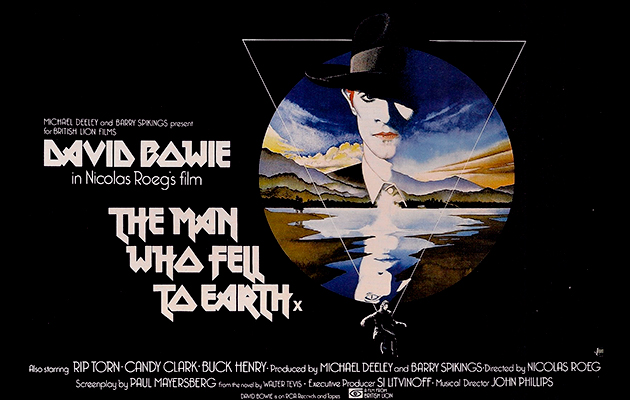“Non-acting” or not, The Man Who Fell To Earth remains Bowie’s greatest film outing. “His performance is incomparable, one of a kind,” gushes Litvinoff. “As good as it gets. I can’t imagine – and I have tried – any other actor in the part.”
On its release in May 1976 (it received its UK premiere in March), critics generally agreed, though the film’s elliptical nature left some cold. In The New Yorker, legendary US reviewer Pauline Kael applauded Bowie as “the most romantic figure in recent pictures, the modern version of the James Dean lost-boy myth”. She likened his demeanour to “Katharine Hepburn in her transvestite role in Sylvia Scarlett”. The Guardian praised the film as a “political and moral allegory”, while The New York Times hailed it as “absorbing and beautiful”, singling out Clark and Bowie for special attention. The latter, said Richard Eder, “acquires a moving, tragic force as the stranger caught and destroyed in a strange land”. Famed US commentator Roger Ebert, meanwhile, found fault not only with detail (Bowie’s spacecraft “looks, so help me, like a hunting lodge with wings”) but with the “gaps of logic and continuity”.
Sniffing a hit, distributors Cinema Five decided to trim it by some 20 minutes. “You really couldn’t make head or tail of the cut version,” considers Clark. “It stinks. I guess they thought, ‘Hey, this is a hit! Let’s chop it to two hours.’ And it was hacked in two days. They hired some people who edited commercials to do it. And this is after Nic Roeg and editor Graeme Clifford had spent nine months cutting it. I was due to go on the road for Cinema Five to promote it, but I bailed out after a day. It was making me sick.”
In the year of Rocky and All The President’s Men, box office business was steady rather than spectacular. “It’s unfortunate that, in the hands of a minor league distributor, not enough people saw it in theatres, despite an excellent critical response,” mourns Litvinoff. “But its audience and classic status are both growing.”
After filming, Bowie threw himself into the Hollywood sessions for Station To Station, during which he sank back into a cokestorm of paranoia, sleep deprivation and black magic, creating, in the process, some of the greatest music (he) ever made. Bowie knew the drugs were killing him. The curtains of his Doheny Drive home permanently drawn, he would sit on the floor and scrawl pentagrams while black candles burned. Physically, he was fading fast. At one point, he weighed under seven stone, living off a diet of red and green peppers washed down with cartons of extra-rich milk. Meal times were 4am and 5am. The coke binges, allied to his phenomenal natural energy, meant he’d stay up for seven or eight days at a time, possessed by hallucinations and visions of doom.
In 1997, he admitted: “I was just paranoid, manic depressive… the usual paraphernalia that comes with the abuse of amphetamines and coke.” There was even the much-fabled occasion when he had his indoor swimming-pool exorcised. Afterwards, according to wife Angie, the shape of the devil appeared at the bottom of the pool.
In November, an appearance on ABC’s premier black music show Soul Train (an incredible coup for a white artist) saw Bowie miming to “Fame” and “Golden Years”. Between takes, he tried to field questions from the MC but was barely coherent.
A few weeks later, a live satellite interview with UK chat show host Russell Harty saw Bowie all glazed expression and anxious tics.
Then, having supposedly secured the deal, a projected score for The Man Who Fell To Earth fell through in December ’75. The Mamas And The Papas’ John Phillips eventually got the soundtrack job. Some commentators still believe that these recordings became 1977’s Low. Not so. As he told Uncut in April 2001: “The only hold-over from the proposed soundtrack that I actually used was the reverse bass part in ‘Subterraneans’.”
Within a year, Bowie had settled in Europe and begun the process of exorcising the demons of his American nightmare.



